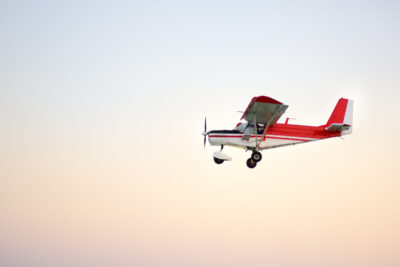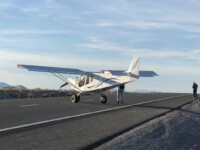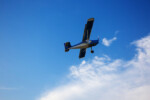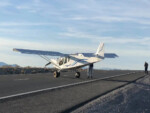Can you Fly an Ultralight Across the Country?
6 March 2023 | Updated on February 05, 2024
Most Americans won’t consider flying an ultralight across the United States in an era of fast, long-range, whisper-quiet, and comfortable commercial airliners. Ultralights are a throwback to early open-cockpit airplanes when pilots sat inside open-air cockpits and endured everything nature threw at them. They are low-flying, slow, noisy, and uncomfortable, with ridiculously short range.
Despite those shortcomings, ultralights provide a thrilling flying experience, where pilots get to experience the sights, sounds, and smells (hopefully not of gasoline) of the scenery underneath and above them. Because ultralights fly so low, pilots rarely get a feeling of detachment experienced by general aviation pilots who are confined in closed cockpits.
Ultralights are easy to fly; you don’t need a pilot’s license to fly them! But can you fly across the United States?
Strap in as we discover if you can hop into an ultralight and take a tour across the United States.


Important Disclaimer: The information and data provided here are for informational purposes only, and are subject to change over time. We strive to provide the most current and relevant information, but the dynamic nature of the topics discussed may result in changes that are not immediately reflected in our content. We recommend our readers to conduct their own research and consult with professionals when making significant decisions based on the data or information provided here. Your reliance on the information in this post is solely at your own risk.
Can you fly an ultralight across the United States of America?
An Ultralight overflight across the United States is possible. Still, the FAA’s restrictions on ultralight flight operations and limitations on ultralight vehicle operations can make such an attempt a prolonged and challenging undertaking without support.
For starters, the FAA (FAR Part 103) rules restrict ultralight flight operations to daylight hours only. This means anyone attempting to fly an ultralight across the United States must find a landing spot by nightfall. This can be problematic because ultralight vehicles are not generally allowed to land at airports.
In 1984, Jack Halbeisen, a licensed pilot, successfully flew across the United States in his ultralight. He planned to complete the trip in 24 days, which took two months. Here is a list of what he had to deal with during his trip.
- He had to plan his fuel stops within a 120-mile range from the previous one because ultralight’s fuel capacity can not legally exceed five gallons. A particularly hair-raising part of the trip was when he ran out of fuel while flying over the West Virginia mountains in high headwinds but managed to land safely on a backcountry road.
- He couldn’t fly his ultralight over any congested area of a city, town, settlement, open-air stadiums, pitches, or playgrounds per Part 103.13 rules.
- He could only fly in Class G airspace below 1,200 feet above ground level. He endured rain and snow conditions because he was prohibited from operating at higher altitudes under Part 103.17 rules.
- He could only fly under visual flight reference VFR with the surface and often had to abandon flight operations on days with poor visibility or low cloud cover, as required by Part 103.21.
It is a good idea to acquaint yourself with FAA laws regarding ultralight flight operations before attempting to fly one across the country. You will need a great strategy to avoid violating FAA ultralight rules and lots of patience to overcome the numerous challenges you will encounter during the trip.
Can you fly an ultralight over a populated area?
According to FAR Part 103.15 rules, you can not fly an ultralight over a populated area. The law states that ‘ no person may operate an ultralight vehicle over any congested area of a city, town, or settlement, or over any open air assembly of persons.’
Ultralight vehicle flights over residential areas are relatively common, but those are more likely to occur in sparsely populated rural communities than in densely populated areas. You must remember that standard airplane rules do not apply to ultralight vehicles. Understanding regulations guiding ultralight operations in your area is a good idea before taking to the skies.
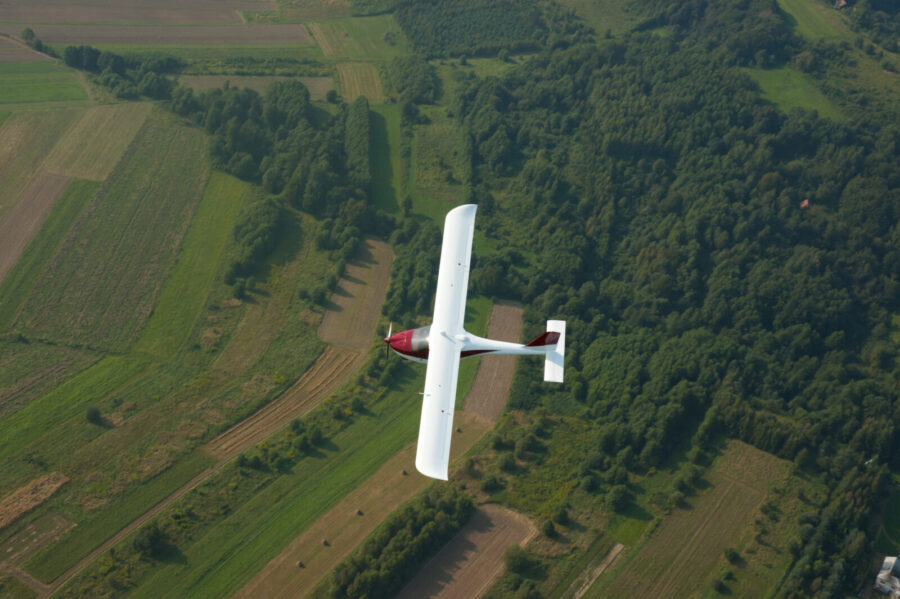

How far can you travel in an ultralight?
Ultralights are not designed for long-distance flights, and any novice pilot attempting to discover the limits of their range could quickly run into serious problems with potentially fatal consequences. A fuel gauge on most ultralights leaves little room for error, and we advise that you remain within visual distance of a landing strip when airborne.
FAR (Part 103) rules for ultralight vehicles do not provide requirements regarding their maximum range. However, FAR rules specify ultralight top speed and fuel tank capacity. But how far you can fly in your ultralight depends on the engine fuel burn rate and weather conditions.
For example, if you are flying in impeccable weather at the legally mandated maximum speed of 55 knots (63.3 mph) per hour with a maximum fuel capacity of 5 gallons. Your ultralight vehicle’s maximum range will be around 180 miles. However, weather conditions, temperatures, and fuel consumption changes may increase the fuel burn rate, reducing the maximum range.
An ultralight vehicle’s maximum range varies per model. Below is the maximum range of some popular ultralight models.
| Ultralight Model | Maximum Range |
| Earthstar Gull 2000 | 165 miles |
| Pterodactyl Ascender | 120 miles |
| Kolb Firestar | 130 miles |
| Hummel Ultracruiser | 180 miles |
| Jordan Lake Air-Bike 103 (fitted with Rotax 447 engine) | 173 miles |
| Merlin Lite | 220 miles |
| Composite FX XEL Helicopter | 60 miles |
| CGS Hawk Arrow II | 170 miles |
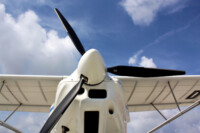

Related
How Fast Can An Ultralight Fly?
Can you land an ultralight at an airport?
You might, but the chances of landing your ultralight vehicle at an airport depend on the airport type and, to a lesser extent, the air traffic control (ATC) officials’ mood. United States aviation laws do not ban ultralight vehicles from landing at airports. But FAR Part 103.17 rules of entry into controlled airspace (consisting of Class A, B, C, D, or E) designated for an airport require ultralight pilots to obtain ‘prior authorization from the ATC facility having jurisdiction over the airspace.’
Landing your ultralight vehicle at a Class B airport like the Hartsfield-Jackson Atlanta International Airport is impossible without a functioning transponder and a two-way radio. However, Part 103 rules do not require ultralight vehicles to have those equipment types. Even if you have a radio or transponder, getting approval to land at a busy Class B airport is impossible. No one wants the burden of guiding a tiny and slow-moving ultralight vehicle in a tightly managed airspace with hundreds of larger aircraft traveling at much faster speeds.
Flying into Class [C|D] towered airports are the same. However, a friendly ATC official might approve an ultralight landing during off-peak hours. Ultralights can always land at non-towered airports, not around controlled airspace. Just remember to radio the airport manager in advance and relate your location.
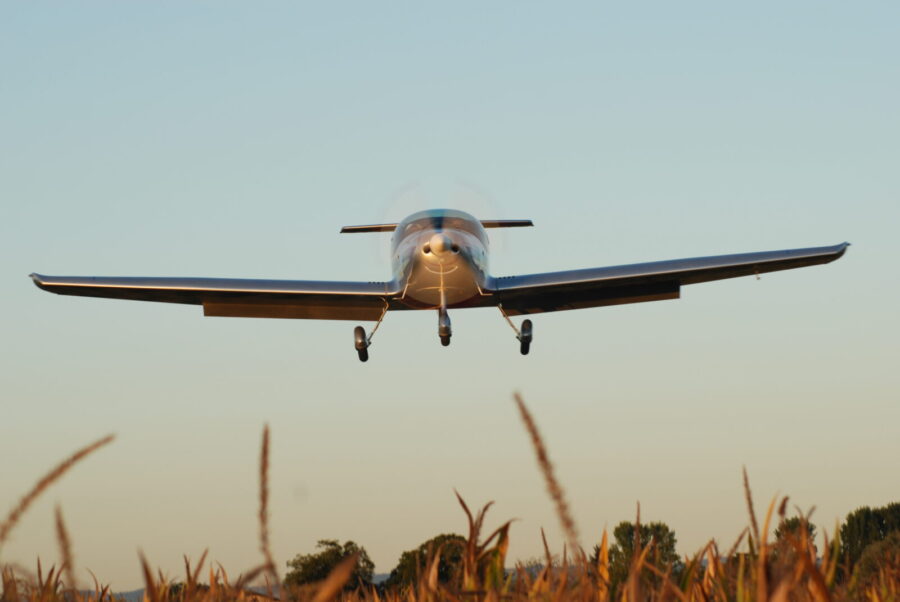

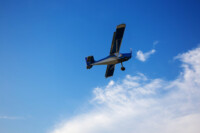

Learn more
Can I Build My Own Ultralight Airplane?
How far can an ultralight go on a tank of gas?
Ultralight vehicles are required by law to carry at most 5 gallons of fuel, limiting their flight range. However, the limited range isn’t an issue when most ultralights fly during the occasional weekend when their owners indulge in a few hours of sports and recreational flying.
Although winds and altitude determine how far a powered ultralight can travel on a tankful of gas, the vehicle’s weight and engine fuel-burn rate are also vital. For example, a 200-pound (90 kg) ultralight vehicle fitted with the Rotax 2-stroke engine and traveling at 48 mph in calm winds has a maximum range of 147 miles or three hours of flight time on a full gas tank.
This figure varies per model and flight conditions because a heavier ultralight will have a lesser range on a full gas tank.
Additionally, head, tail, and crosswinds can significantly impact your ultralight vehicle’s maximum range on a full gas tank. Experiencing a 20-knot headwind can reduce your ultralight maximum range on a full gas tank by almost fifty percent.
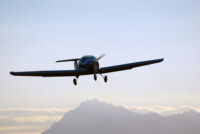

Learn more
How Much Does An Ultralight Cost?
Do you need a flight plan for an ultralight?
Unless you plan to fly using instrument flight rules (IFR), into busy airports, or in Class [A|B|C|D|E] airspace, you do not need to file a flight plan for an ultralight vehicle in the United States. Federal aviation regulations don’t require a flight plan to fly an ultralight. All you need to do is fly using visual flight rules (VFR), and you may fly across the United States without getting radio clearance from ATC.
Pilots can only fly using VFR when weather conditions allow clear visibility for at least three miles in every direction, and you can fly low enough to navigate by visual landmarks and use the aircraft’s relative position to determine your position. However, we recommend announcing your position to other pilots or airport managers when approaching small non-towered airports to help make air traffic safer.
You will be fine if you fly in clear weather, stay under 18,000 feet, talk to other pilots, and remain within Class [E|G] airspace.


In what airspace can I fly an ultralight?
Far (Part 103.17) rules on ultralight operations in certain airspace are clear on what airspace you are permitted to fly your ultralight vehicle.
It states that “No person may operate an ultralight vehicle within Class A, Class B, Class C, or Class D airspace or within the lateral boundaries of the surface area of Class E airspace designated for an airport unless that person has prior authorization from the ATC facility having jurisdiction over that airspace.”
Authorities encourage ultralight pilots to remain in Class G airspace because the conditions generally favorable for ultralight operations exist within those corridors.
Below is a table indicating the various airspace classes, including flight visibility and cloud clearance requirements.
| Airspace | Visibility | Distance from clouds |
| Class A | Not Applicable | Not Applicable |
| Class B | 3 Statute Miles | Clear of Clouds |
| Class C | 3 Statute Miles | 500 feet below 1,000 feet above 2,000 feet horizontal |
| Class D | 3 Statute Miles | 500 feet below 1,000 feet above 2,000 feet horizontal |
| Class E Less than 10,000 feet MSL | 3 Statute Miles | 500 feet below 1,000 feet above 2,000 feet horizontal |
| Class E At or above 10,000 feet MSL | 5 statute miles | 1,000 feet below 1,000 feet above 1 statute mile horizontal |
| Class G 1,200 feet or less above the surface( regardless of MSL altitude) | 1 statute mile | Clear of clouds |
MSL = Mean Sea Level
How high can an ultralight fly?
U.S. aviation regulations allow ultralight vehicles to fly without restrictions in Class G airspace, 1,200 feet or less above the ground surface. Several modern ultralight vehicle models can soar up to 10,000 feet above sea level, and some brave pilots can attempt to reach higher altitudes if they choose.
Taking your ultralight above Class G airspace requires ATC authorization, and the odds of you receiving clearance are slim. Also, flying above 10,000 feet may contravene FAA 14 CFR (Part 91.211-225) aviation rules because ultralights do not have the legally mandated equipment for high-altitude flight operations.
Some of those requirements include
- Supplemental oxygen must be provided in aircraft cabins at altitudes above 12,500 feet (MSL).
- Pressurized cabins for aircraft venturing beyond 18,000 feet.
Also, pilots operating in Class A airspace (above 18,000 feet) must fly under instrument flight rules (IFR) which require navigation and radar systems.
How much fuel does an ultralight use?
In an era of high gas prices, it would be tempting to dump your vehicle and use your ultralight as a daily driver. Of course, it wouldn’t be a practical alternative for all the reasons explained earlier in the article, but the lower fuel consumption of an ultralight makes such ideas enticing.
Most ultralight vehicles have a 503 Rotax 2-stroke engine producing 53hp or a 582 Rotax 2-stroke engine producing 65hp. Both Rotax powerplants are incredibly frugal and burn around three to four gallons of gas per hour.
Of course, your ultralight burns less fuel when hopping along at slower speeds.
Conclusion
Ultralight vehicles are the bicycles of the sky and a cheap, fun alternative to conventional airplanes. They are a great way to enjoy the joys of flying without being on the hook for several thousands of dollars in aircraft purchase and maintenance costs. Ultralights are best enjoyed during a weekend of recreational flying. But with the right amount of preparation and experience, you may jolly well take one on a cross-country jaunt.




















